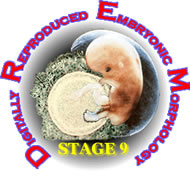Embryos
of stage 9 are very rare. They have a greatest length of 1.5 to 2.5 mm and an estimated postfertilization age of 25 days. Neural folds are present and somites make their first appearance.
Stage 9 is represented in the DREM databases by Carnegie
embryo # 3709. This
embryo was initially classified as an early stage 10 specimen because it has 4 pairs of somites,
however, many of its features are consistent with stage 9, particularly
the level of cardiovascular and nervous system development. It has
been reclassified as a late stage 9 and given a grade of poor. It was selected for digital replication
because it is the best transversely sectioned specimen
in the collection at this stage.
The age
of the embryo is estimated to be 25 postfertilization days which places
it at the end of stage 9. It has a greatest length of 1.74 mm
(after fixation) and there are four pairs of somites along the body
axis .
This
specimen was prepared for microscopic examination in 1921, and was
originally part of the collection (#H 279) housed at the University
of Chicago. The embryo was fixed in formol, embedded in paraffin,
and serially sectioned transverse to the long axis at 10 microns.
The sections were mounted on 2 large glass slides and stained with
erythrosin. There are 153 sections through the embryo.
The
morphology of this embryo has been documented
in the literature.
The DREM
database includes all 153 of the sections. The sections have been
digitally restored and labeled, and can be viewed at four magnifications.
Several 3D reconstructions have been produced
from the aligned sections. Animations of the 3D-reconstructions of
the embryo surface and the internal
anatomy together with a fly-through animations
of the aligned sections are also included on the disks. For anyone
who wishes to use them for other reconstructions, research or presentations,
all of the original section images are available as individual
.jpg files. These files are also available as zip
files.
Instructions
for using the disks can be found by going to the
Instructions section from the opening screen.


